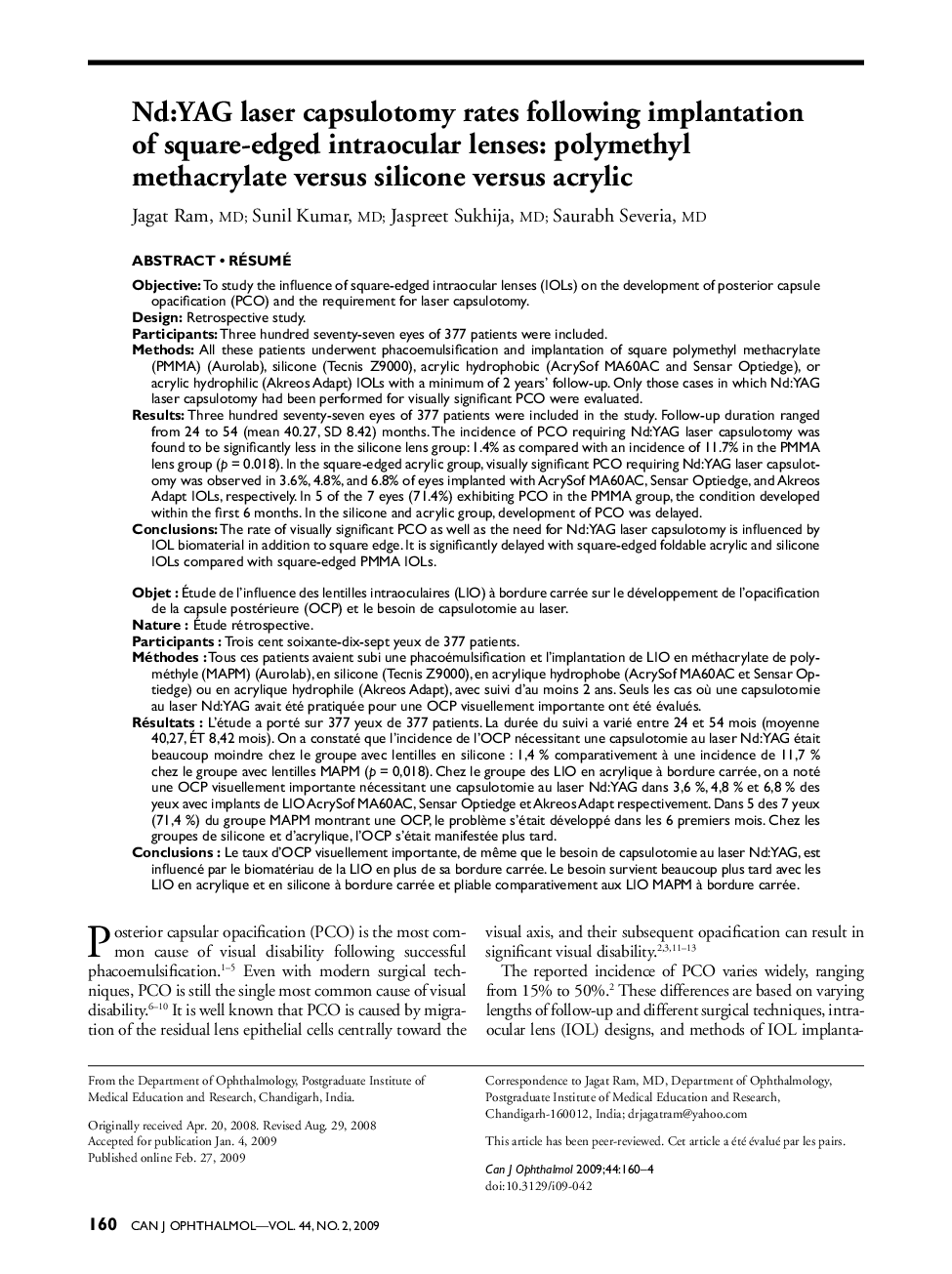| کد مقاله | کد نشریه | سال انتشار | مقاله انگلیسی | نسخه تمام متن |
|---|---|---|---|---|
| 4009956 | 1602436 | 2009 | 5 صفحه PDF | دانلود رایگان |

Objective: To study the influence of square-edged intraocular lenses (lOLs) on the development of posterior capsule opacification (PCO) and the requirement for laser capsulotomy.Design: Retrospective study.Participants: Three hundred seventy-seven eyes of 377 patients were included.Methods: All these patients underwent phacoemulsification and implantation of square polymethyl methacrylate (PMMA) (Aurolab), silicone (Tecnis Z9000), acrylic hydrophobic (AcrySof MA60AC and Sensar Optiedge), or acrylic hydrophilic (Akreos Adapt) lOLs with a minimum of 2 years’ follow-up. Only those cases in which Nd:YAG laser capsulotomy had been performed for visually significant PCO were evaluated.Results: Three hundred seventy-seven eyes of 377 patients were included in the study. Follow-up duration ranged from 24 to 54 (mean 40.27, SD 8.42) months. The incidence of PCO requiring Nd:YAG laser capsulotomy was found to be significantly less in the silicone lens group: 1.4% as compared with an incidence of 11.7% in the PMMA lens group (p = 0.018). In the square-edged acrylic group, visually significant PCO requiring Nd:YAG laser capsulotomy was observed in 3.6%, 4.8%, and 6.8% of eyes implanted with AcrySof MA60AC, Sensar Optiedge, and Akreos Adapt lOLs, respectively. In 5 of the 7 eyes (71.4%) exhibiting PCO in the PMMA group, the condition developed within the first 6 months. In the silicone and acrylic group, development of PCO was delayed.Conclusions: The rate of visually significant PCO as well as the need for Nd:YAG laser capsulotomy is influenced by IOL biomaterial in addition to square edge. It is significantly delayed with square-edged foldable acrylic and silicone lOLs compared with square-edged PMMA IOLs.
RésuméObjet: Étude de l’influence des lentilles intraoculaires (LIO) à bordure carrée sur le développement de opacification de la capsule postérieure (OCP) et le besoin de capsulotomie au laser.Nature: Étude rétrospective.Participants: Trois cent soixante-dix-sept yeux de 377 patients.Méthodes: Tous ces patients avaient subi une phacoémulsification et l’implantation de LIO en méthacrylate de polyméthyle (MAPM) (Aurolab), en silicone (Tecnis Z9000), en acrylique hydrophobe (AcryS of MA60AC et Sensar Optiedge) ou en acrylique hydrophile (Akreos Adapt), avec suivi d’au moins 2 ans. Seuls les cas où une capsulotomie au laser Nd:YAG avait été pratiquée pour une OCP visuellement importante ont été évalués.Résultats: L’étude a porté sur 377 yeux de 377 patients. La durée du suivi a varié entre 24 et 54 mois (moyenne 40,27, ÉT 8,42 mois). On a constaté que l’incidence de l’OCP nécessitant une capsulotomie au laser Nd:YAG était beaucoup moindre chez le groupe avec lentilles en silicone: 1,4 % comparativement à une incidence de 11,7 % chez le groupe avec lentilles MAPM (p = 0,018). Chez le groupe des LIO en acrylique à bordure carrée, on a noté une OCP visuellement importante nécessitant une capsulotomie au laser Nd:YAG dans 3,6 %, 4,8 % et 6,8 % des yeux avec implants de LIO AcrySof MA60AC, Sensar Optiedge et Akreos Adapt respectivement. Dans 5 des 7 yeux (71,4 %) du groupe MAPM montrant une OCP, le problème s’était développé dans les 6 premiers mois. Chez les groupes de silicone et d’acrylique, l’OCP s’était manifestée plus tard.Conclusions: Le taux d’OCP visuellement importante, de même que le besoin de capsulotomie au laser Nd:YAG, est influencé par le biomatériau de la LIO en plus de sa bordure carrée. Le besoin survient beaucoup plus tard avec les LIO en acrylique et en silicone à bordure carrée et pliable comparativement aux LIO MAPM à bordure carrée.
Journal: Canadian Journal of Ophthalmology / Journal Canadien d'Ophtalmologie - Volume 44, Issue 2, April 2009, Pages 160-164